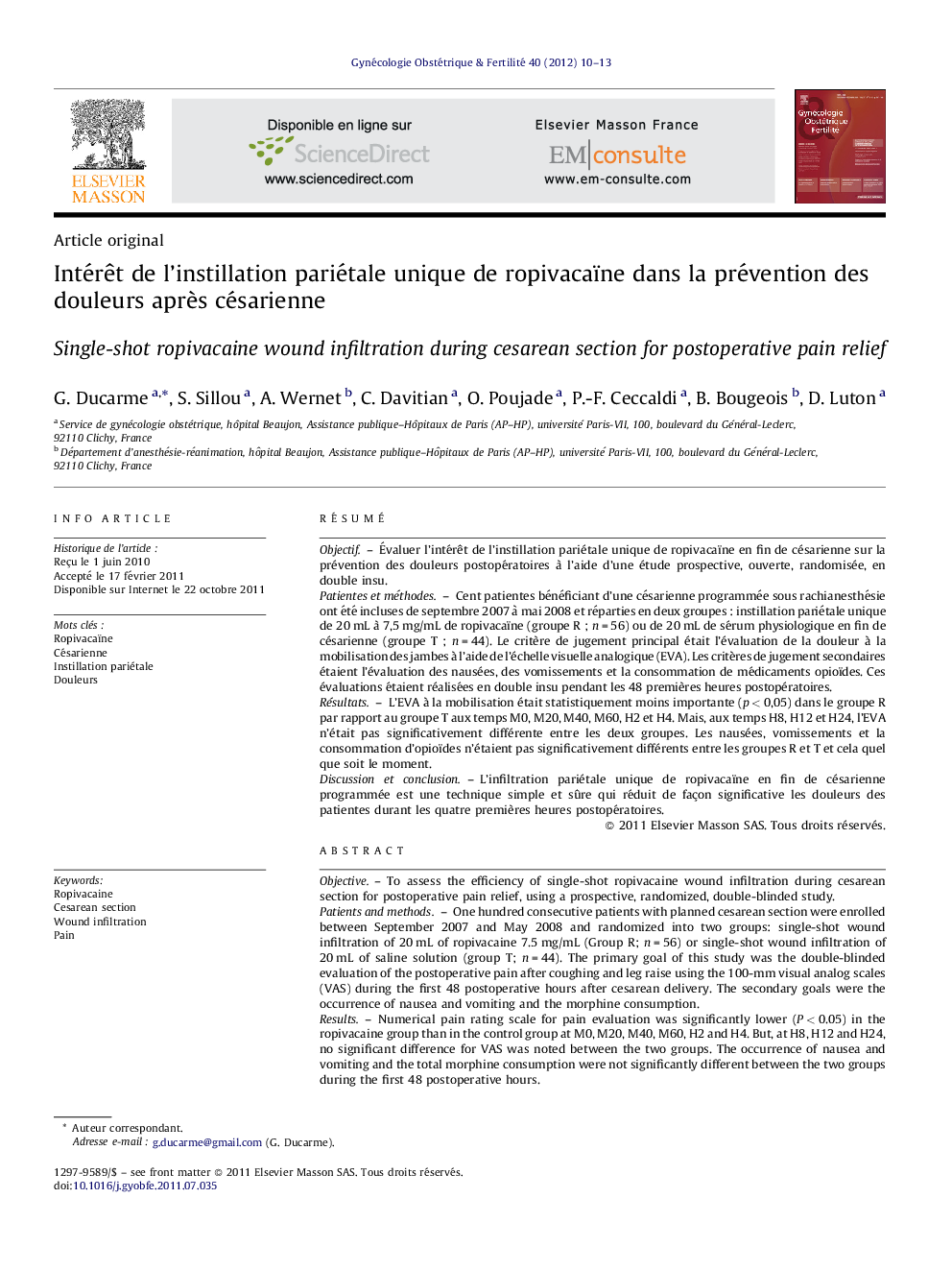| Article ID | Journal | Published Year | Pages | File Type |
|---|---|---|---|---|
| 3949271 | Gynécologie Obstétrique & Fertilité | 2012 | 4 Pages |
RésuméObjectifÉvaluer l’intérêt de l’instillation pariétale unique de ropivacaïne en fin de césarienne sur la prévention des douleurs postopératoires à l’aide d’une étude prospective, ouverte, randomisée, en double insu.Patientes et méthodesCent patientes bénéficiant d’une césarienne programmée sous rachianesthésie ont été incluses de septembre 2007 à mai 2008 et réparties en deux groupes : instillation pariétale unique de 20 mL à 7,5 mg/mL de ropivacaïne (groupe R ; n = 56) ou de 20 mL de sérum physiologique en fin de césarienne (groupe T ; n = 44). Le critère de jugement principal était l’évaluation de la douleur à la mobilisation des jambes à l’aide de l’échelle visuelle analogique (EVA). Les critères de jugement secondaires étaient l’évaluation des nausées, des vomissements et la consommation de médicaments opioïdes. Ces évaluations étaient réalisées en double insu pendant les 48 premières heures postopératoires.RésultatsL’EVA à la mobilisation était statistiquement moins importante (p < 0,05) dans le groupe R par rapport au groupe T aux temps M0, M20, M40, M60, H2 et H4. Mais, aux temps H8, H12 et H24, l’EVA n’était pas significativement différente entre les deux groupes. Les nausées, vomissements et la consommation d’opioïdes n’étaient pas significativement différents entre les groupes R et T et cela quel que soit le moment.Discussion et conclusionL’infiltration pariétale unique de ropivacaïne en fin de césarienne programmée est une technique simple et sûre qui réduit de façon significative les douleurs des patientes durant les quatre premières heures postopératoires.
ObjectiveTo assess the efficiency of single-shot ropivacaine wound infiltration during cesarean section for postoperative pain relief, using a prospective, randomized, double-blinded study.Patients and methodsOne hundred consecutive patients with planned cesarean section were enrolled between September 2007 and May 2008 and randomized into two groups: single-shot wound infiltration of 20 mL of ropivacaine 7.5 mg/mL (Group R; n = 56) or single-shot wound infiltration of 20 mL of saline solution (group T; n = 44). The primary goal of this study was the double-blinded evaluation of the postoperative pain after coughing and leg raise using the 100-mm visual analog scales (VAS) during the first 48 postoperative hours after cesarean delivery. The secondary goals were the occurrence of nausea and vomiting and the morphine consumption.ResultsNumerical pain rating scale for pain evaluation was significantly lower (P < 0.05) in the ropivacaine group than in the control group at M0, M20, M40, M60, H2 and H4. But, at H8, H12 and H24, no significant difference for VAS was noted between the two groups. The occurrence of nausea and vomiting and the total morphine consumption were not significantly different between the two groups during the first 48 postoperative hours.Discussion and conclusionSingle-shot ropivacaine wound infiltration during planned cesarean section is a simple and safe procedure that provides effective reduction of post-partum pain within the first 4 hours.
